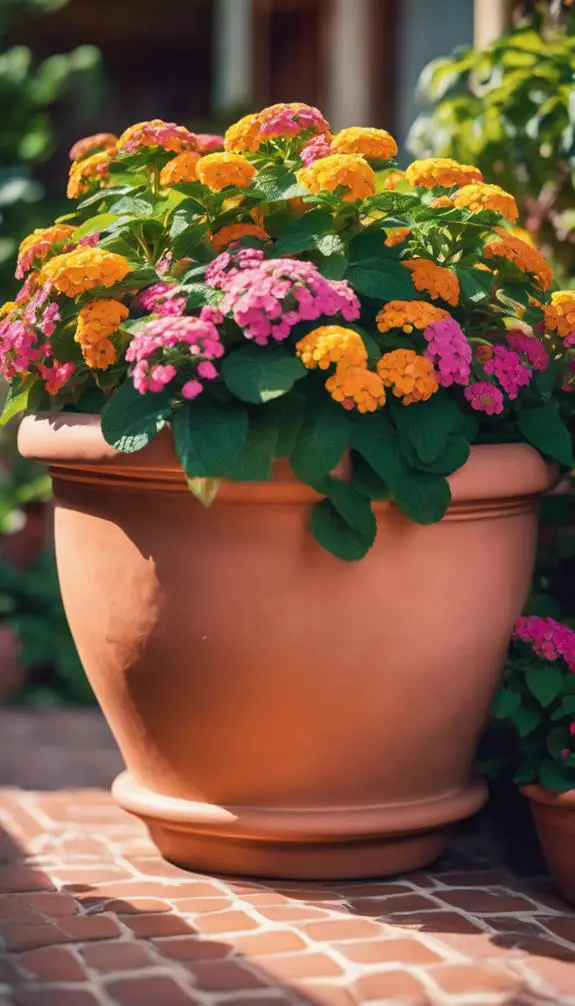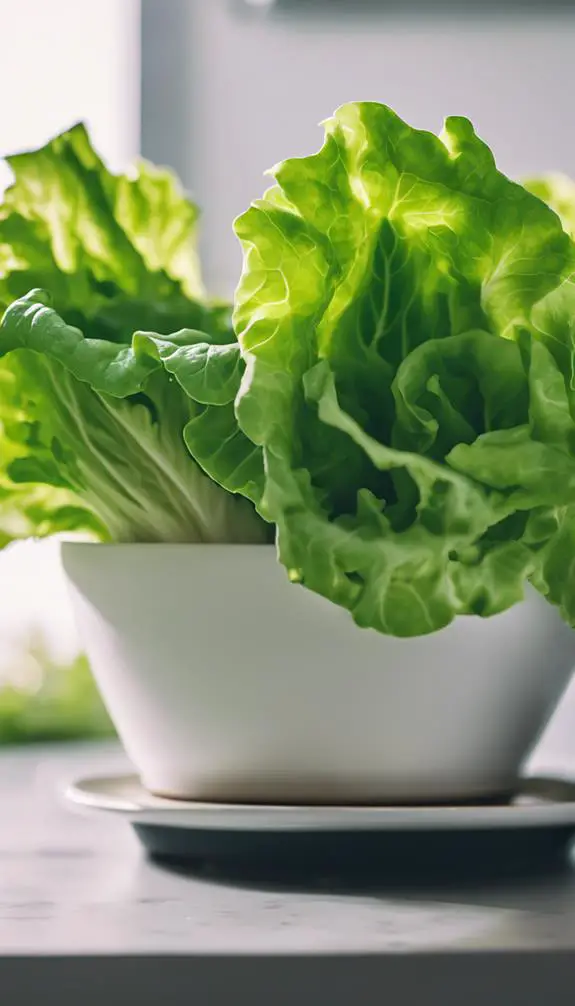You're about to discover the secret to growing crisp, fresh lettuce right in your own backyard. It all starts with selecting the perfect variety for your climate and taste preferences. With so many types to choose from, you'll want to ponder factors like growth rate, leaf color, and disease resistance. Once you've made your selection, it's time to prepare the soil and sow those seeds. But what's the ideal soil composition, and how deep should you plant those tiny seeds? The answers to these questions will set you on the path to a bountiful lettuce harvest.
Summary
- Choose a lettuce variety that suits your specific needs, considering factors like flavor profile, growing conditions, and intended use.
- Sow lettuce seeds indoors 2-4 weeks before the last frost, or directly outdoors when the soil has warmed up to at least 40°F (4°C).
- Provide lettuce with a consistent temperature between 60°F and 70°F (15°C and 21°C), partial shade, and 4-6 hours of direct sunlight daily.
- Water lettuce consistently, providing about 1-2 inches of water per week, and avoid overwatering, which can lead to root rot and other issues.
- Fertilize lettuce plants when they're about 2-3 inches tall, using a balanced fertilizer with a nitrogen-phosphorus-potassium (NPK) ratio of 5-5-5 or 10-10-10.
Choosing the Right Lettuce Variety
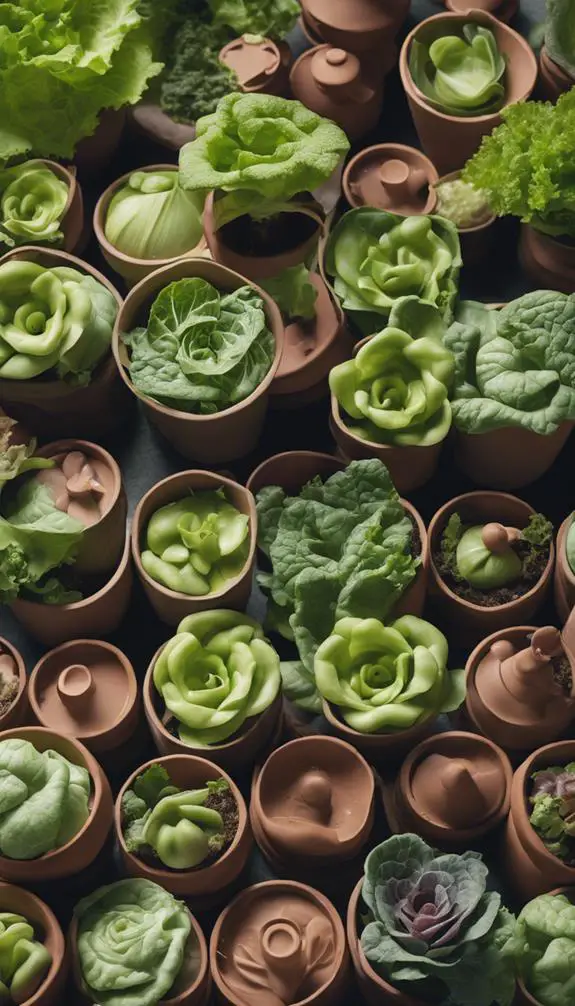
When selecting a lettuce variety, consider the intended use, desired flavor profile, and growing conditions, as these factors substantially influence the success of your crop.
You'll want to choose a lettuce type that suits your needs, whether it's crisphead for fresh cuts, loose-leaf for salads, or romaine for its distinctive flavor.
Flavor profiles range from mild and sweet to bitter and tangy, so consider the taste you're aiming for.
Some lettuce varieties thrive in cooler temperatures, while others prefer warmer climates.
Research the specific growing conditions required by your chosen variety to guarantee maximum growth.
Preparing the Soil for Sowing

You'll need to assess your soil type, as lettuce grows best in well-draining, fertile soils with a mix of sand, silt, and clay.
Lettuce is sensitive to soil pH, so you'll want to guarantee it falls between 6.0 and 6.5, as higher or lower pH levels can hinder growth.
Additionally, you'll need to attain ideal soil moisture levels, with a consistent supply of water but not waterlogging, as lettuce is prone to root rot in soggy conditions.
Soil Type Considerations
As you prepare the soil for sowing, keep in mind that examining the type of soil you're working with is vital, since lettuce has specific requirements to thrive.
Lettuce prefers well-draining, loose soil with good aeration, which allows roots to breathe and absorb nutrients efficiently. Avoid compacted soil, as it can hinder root growth and lead to poor germination rates.
If your soil is heavy clay or prone to compaction, mix in organic matter like compost or perlite to improve its structure. Additionally, consider raised beds or containers with a well-draining potting mix to guarantee ideal soil conditions.
Lettuce Soil Ph Needs
Lettuce thrives in a narrow pH range, between 6.0 and 6.5, which allows for ideal nutrient uptake.
This vital pH range is pivotal, as it affects the solubility of essential nutrients like nitrogen, phosphorus, and potassium.
If your soil is too acidic or alkaline, lettuce growth will suffer. You'll need to test your soil pH to determine if adjustments are necessary.
Soil testing kits or pH meters can help you determine your soil's acidity level.
If your soil pH falls outside the ideal range, you can add lime to raise the pH or elemental sulfur or peat moss to lower it.
Soil Moisture Levels
Perfectly hydrated soil is crucial for sowing lettuce seeds, as it directly impacts germination rates and subsequent growth.
You'll want to maintain ideal soil moisture levels, typically between 20-40% water holding capacity. To achieve this, you can utilize soil sensors to monitor moisture levels and adjust watering schedules accordingly.
Additionally, consider the water table's depth and proximity to your planting area, as this can affect soil moisture levels.
By maintaining ideal soil moisture, you'll create an environment conducive to healthy germination and growth. Guarantee you're not overwatering, which can lead to root rot and other issues.
With precise control over soil moisture, you'll be well on your way to a successful lettuce harvest.
Sowing Lettuce Seeds Indoors
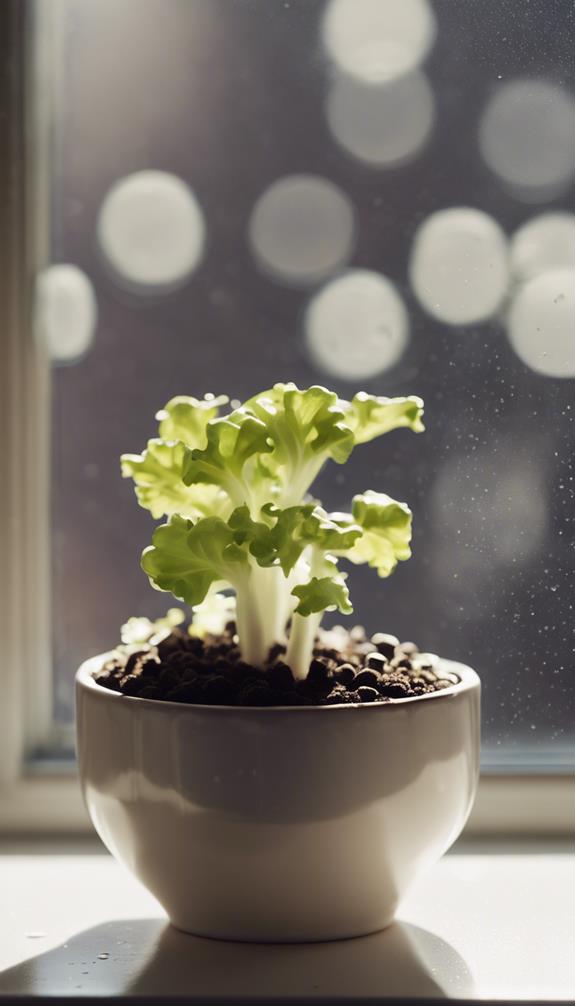
Within a few weeks of the last frost, you can begin sowing lettuce seeds indoors, giving them a head start on the growing season.
For indoor sowing, use seed trays or small pots filled with a well-draining seed starting mix. Sow seeds 1/8 inch deep and 2-4 inches apart. Water gently but thoroughly.
Provide adequate light, maintaining a temperature of 65-70°F (18-21°C) for ideal lettuce germination. Keep the soil consistently moist but not waterlogged.
Transplant seedlings outdoors when they've 2-3 sets of leaves, usually within 1-2 weeks. With proper indoor sowing, you'll be enjoying fresh, crisp lettuce in no time.
Sowing Lettuce Seeds Outdoors

When the soil has warmed up to at least 40°F (4°C), you're ready to sow lettuce seeds directly outdoors.
Choose a location that receives partial shade, especially in warmer outdoor climates. Sow seeds 1/8 inch deep and 2-4 inches apart, depending on the lettuce variety's mature size and desired lettuce spacing.
You can also sow in rows, with seeds spaced 1-2 inches apart, and rows 12-18 inches apart. Water gently but thoroughly after sowing.
Certify the soil remains consistently moist during the germination period, usually 7-10 days. As the seedlings emerge, thin them to the recommended spacing to prevent overcrowding and promote healthy growth.
Providing Optimal Growing Conditions
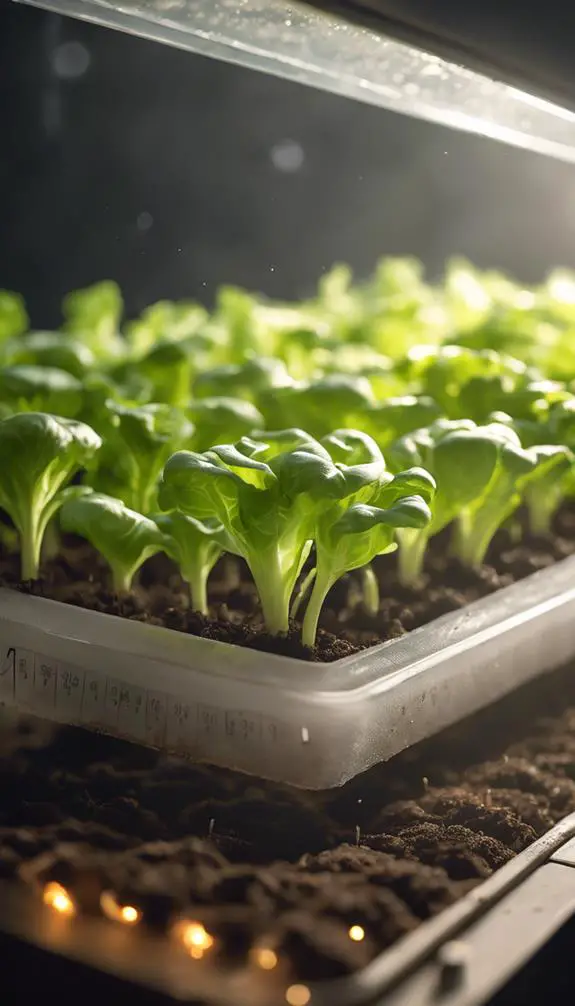
Your lettuce crop's success hinges on providing ideal growing conditions.
You'll want to create a climate that's cool, yet not cold. Aim for temperatures between 60°F and 70°F (15°C and 21°C) for peak growth. Climate control is vital, as lettuce is sensitive to extreme temperatures.
With regard to light exposure, lettuce requires partial shade, especially in warmer climates. Direct sunlight can cause leaves to become bitter, so consider using shade cloth or row covers to filter the sun's rays.
Guarantee your lettuce receives 4-6 hours of direct sunlight and 2-4 hours of indirect sunlight daily. By controlling the climate and light exposure, you'll be well on your way to growing a healthy, thriving lettuce crop.
Watering and Moisture Control
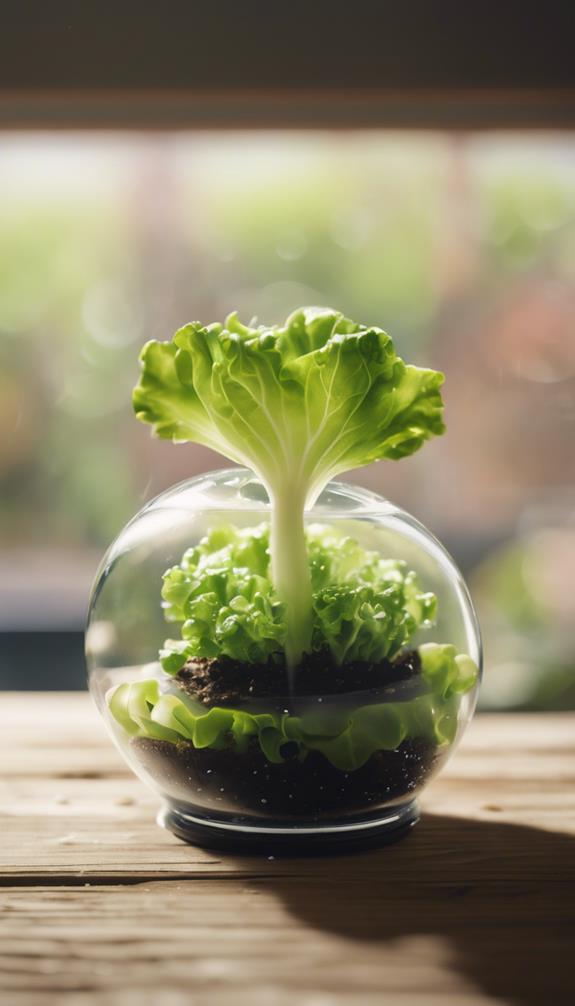
Lettuce roots need consistent moisture to support healthy growth, so it's crucial to achieve a perfect harmony of water and air in the soil.
You'll want to establish a watering schedule that provides about 1-2 inches of water per week, either from rain or irrigation.
To guarantee ideal moisture levels, use a moisture meter to measure the soil's water content. This tool will help you avoid overwatering, which can lead to root rot and other issues.
Check the meter daily, and water when the reading indicates the soil is dry to a depth of 2-3 inches.
Controlling Pests and Diseases
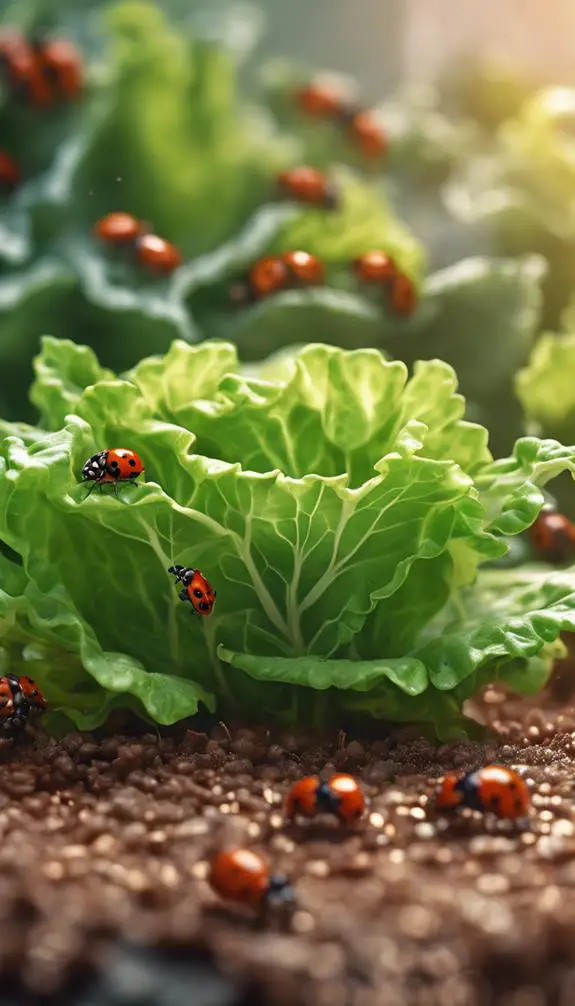
You'll need to monitor your lettuce crop regularly to catch pest and disease issues early, as they can quickly destroy your harvest.
Effective pest control methods, such as introducing beneficial insects and using row covers, can help minimize damage.
Meanwhile, being able to identify common lettuce diseases, like powdery mildew and leaf spot, is vital for administering targeted treatments.
Pest Control Methods
Effective pest control methods are essential to growing healthy lettuce, as these leafy greens are susceptible to various pests and diseases that can substantially reduce yields and affect quality.
You can use companion planting to deter pests. For instance, planting marigolds with lettuce can repel nematodes, while basil can ward off aphids and spider mites.
Natural repellents, such as neem oil and pyrethrin, can also be used to control pests. These organic solutions are safer for the environment and human consumption.
Additionally, crop rotation and removing weeds can help reduce pest infestations. By implementing these pest control methods, you can minimize damage and promote healthy growth, ensuring a bountiful harvest of crisp, flavorful lettuce.
Common Lettuce Diseases
During the growth stage, your lettuce crop is also susceptible to various diseases that can substantially impact yields and quality.
Fungal infections, such as lettuce blight, can spread quickly and cause significant damage. These infections often manifest as yellowing or browning leaves, and can be triggered by overwatering, high humidity, or poor air circulation.
To prevent fungal infections, guarantee your lettuce plants receive adequate air circulation, and avoid overhead watering. You should also remove any infected leaves or plants to prevent the disease from spreading.
Regularly inspect your crop for signs of disease and take prompt action to prevent the spread of infection.
Fertilizing Lettuce Plants
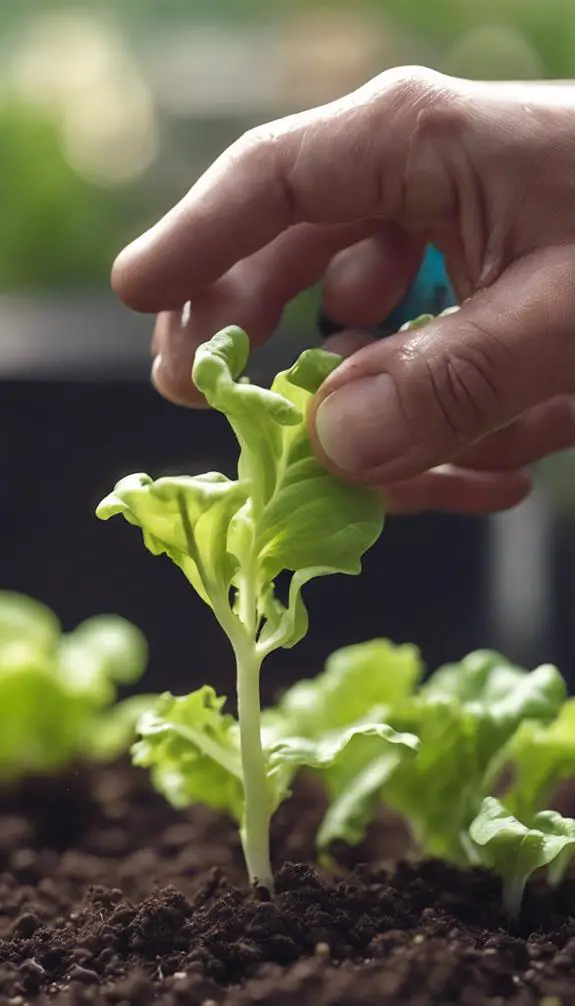
When it comes to fertilizing lettuce plants, pick the right moment to feed them, as this cruciferous crop is a heavy feeder that requires a steady supply of nutrients to thrive.
Lettuce nutrition is vital, and timing is everything. You'll want to fertilize your lettuce plants when they're about 2-3 inches tall, usually around 7-10 days after sowing.
Use a balanced fertilizer with a nitrogen-phosphorus-potassium (NPK) ratio of 5-5-5 or 10-10-10. Apply the fertilizer according to the manufacturer's instructions, taking care not to overfertilize, which can lead to weak, leggy growth.
Proper fertilizer timing guarantees your lettuce plants receive the necessary nutrients for peak growth and flavor.
Thinning and Transplanting Seedlings
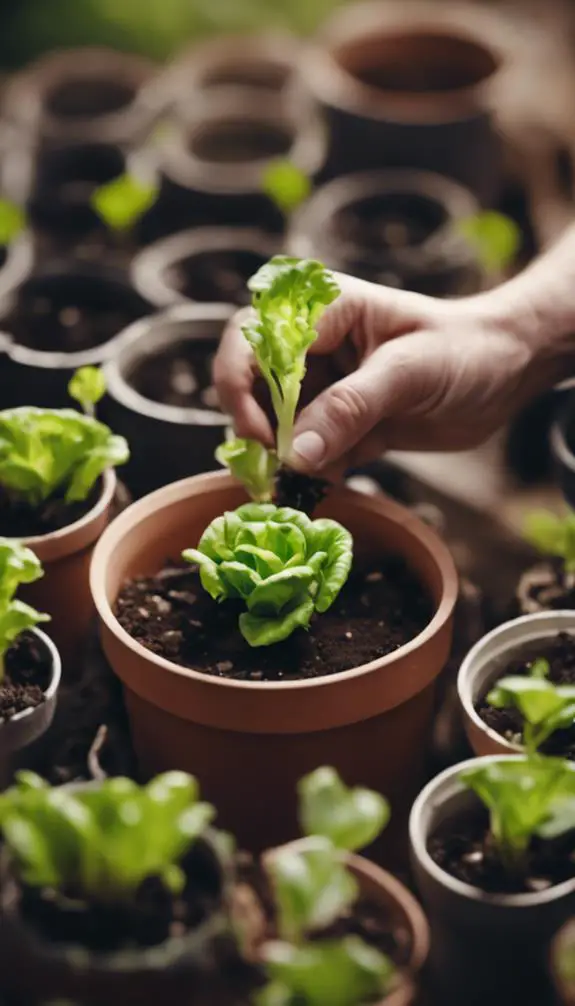
You'll need to carefully select seedlings to thin and transplant, considering factors like leaf shape, color, and size to guarantee only the strongest plants are left to mature.
Timing is also vital, as transplanting too early or too late can lead to stunted growth or bolting.
Seedling Selection Criteria
Seedling selection criteria involve evaluating the health and vigor of young lettuce plants to identify the strongest contenders for thinning and transplanting.
When selecting seedlings, you'll want to assess their overall seedling strength, which is indicated by sturdy stems, robust roots, and a well-developed leaf structure.
Examine the leaf texture, looking for leaves that are crisp, tender, and free of tears or holes.
You'll also want to inspect the color, opting for seedlings with deep green or red leaves, depending on the variety.
Avoid seedlings with yellow, wilted, or spindly leaves, as these may be weaker or more prone to disease.
Transplanting Timing Tips
Timing is everything when it comes to transplanting lettuce seedlings. You want to minimize transplant shock and seedling stress, ensuring a successful shift from indoor sowing to outdoor growing.
Wait until your seedlings have 2-3 sets of leaves, usually around 7-10 days after sowing. This allows them to develop a robust root system, making them more resilient to transplanting.
When transplanting, handle the seedlings by their leaves, not their stems, to avoid damaging the delicate tissue. Gently firm the soil around the roots to prevent air pockets. Water thoroughly after transplanting to settle the soil and provide adequate moisture.
Spacing for Optimal Growth
Proper spacing is crucial for lettuce plants to grow unhindered, allowing for ideal leaf development and air circulation to prevent disease.
When transplanting seedlings, you'll want to space them correctly to achieve peak growth. Aim for a lettuce density of 2-4 inches between plants, depending on the variety.
For row spacing, maintain a minimum of 12-18 inches between rows to allow for easy access and air circulation. This spacing also enables you to easily identify and remove any weak or diseased plants, promoting healthy growth.
Supporting Lettuce Plants Growth
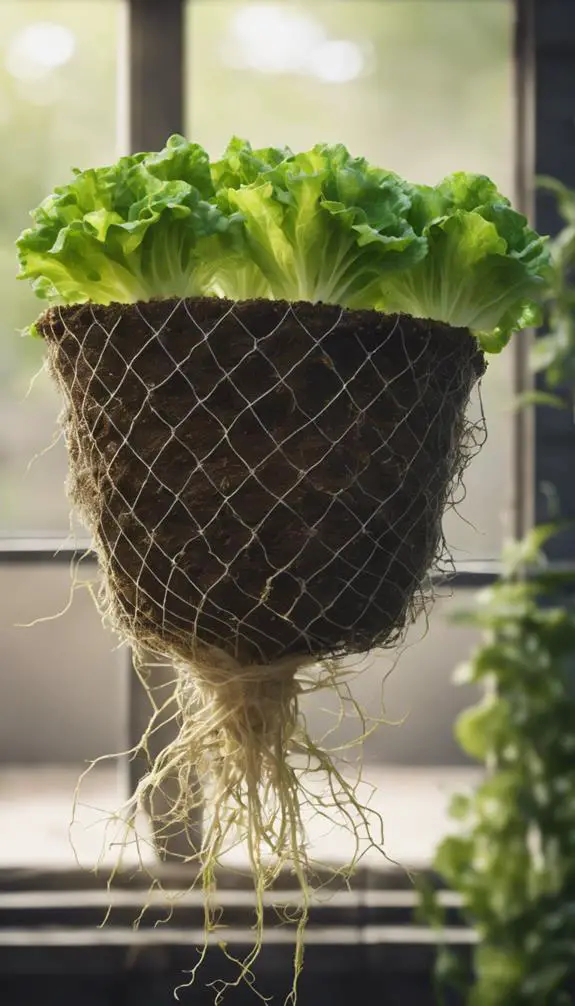
As you nurture your lettuce plants, providing the right support becomes crucial to promote healthy growth and maximize yields.
Lettuce plants can be prone to bolting, which means they'll focus energy on producing seeds rather than leaves. To prevent this, you'll need to provide support through lettuce pruning.
Remove any weak or spindly growth, and trim back the plant to encourage bushy growth. Additionally, consider using shade cloth to filter intense sunlight, which can cause lettuce to bolt.
This will help maintain a consistent temperature and humidity level, ideal for lettuce growth. By providing the right support, you'll be able to enjoy a bountiful harvest of crisp, delicious lettuce leaves.
Monitoring for Common Issues
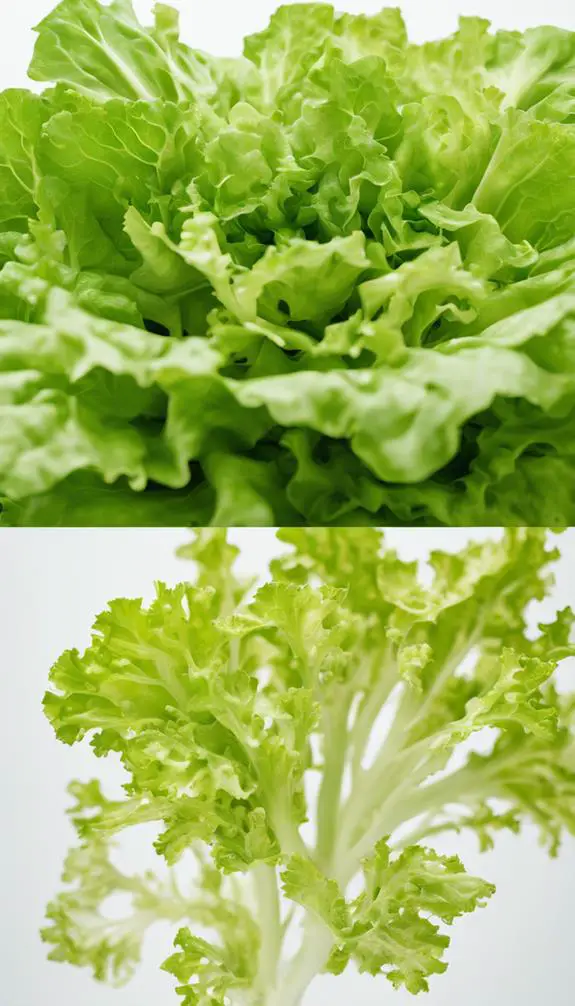
Among the rows of lush green lettuce, keep a watchful eye out for signs of trouble, as undetected issues can quickly spread and devastate your crop.
You'll want to inspect your plants regularly for signs of Lettuce Pests like aphids, slugs, and snails, which can chew holes in leaves and stunt growth.
Check for yellowing or wilted leaves, which can indicate Seedling Shock, a common issue when transplanting seedlings.
Make sure to also monitor for fungal diseases like powdery mildew and leaf spot, which can be triggered by excess moisture.
Early detection is key to preventing the spread of these issues and ensuring a healthy, thriving crop.
Harvesting Lettuce at the Right Time
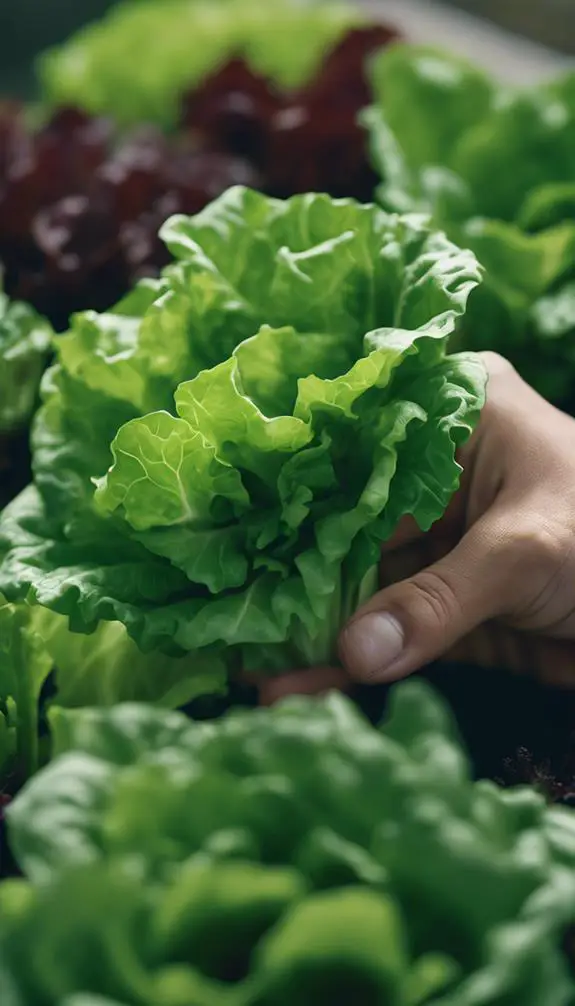
Timing is everything when it comes to harvesting lettuce, and you'll want to catch your crop at the peak of freshness to guarantee the best flavor and texture.
Check for lettuce maturity by monitoring leaf size, color, and texture. For loose-leaf varieties, harvest individual leaves when they reach 2-4 inches in length.
For head-forming varieties, wait until the leaves form a compact, dense head. Harvest timing is critical, as lettuce left in the soil too long can become bitter or bolt.
Check your crop daily, and harvest in the morning, when leaves are at their crispest. Use scissors or pinch off leaves at the base to avoid damaging the plant, allowing it to continue producing new growth.
Storing and Preserving Fresh Lettuce
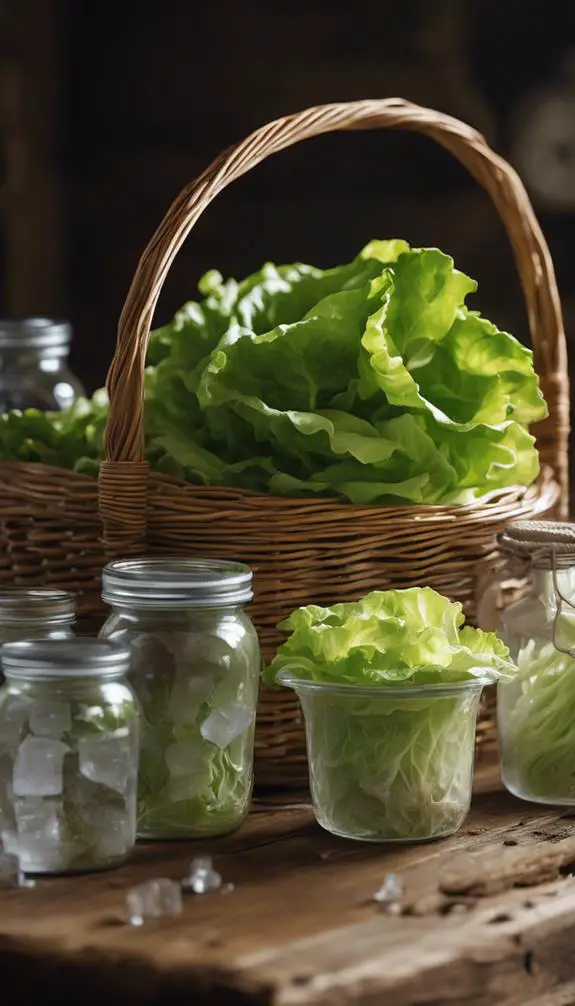
Once you've harvested your fresh lettuce, this is vital to store it properly to maintain its crispness and flavor.
You'll want to wash and dry the leaves thoroughly to prevent moisture from accumulating and causing spoilage.
For short-term storage, place the lettuce in a breathable container, such as a mesh bag or a paper towel-lined container, and refrigerate at 32°F to 40°F (0°C to 4°C).
For longer-term preservation, consider vacuum sealing and freezer storage. This method allows you to store lettuce for up to 8 months.
Simply blanch the leaves in boiling water for 30 seconds, then quickly chill them in an ice bath before vacuum sealing and placing them in the freezer at 0°F (-18°C) or below.
FAQs
Can I Grow Lettuce in Pots or Containers?
You can successfully grow lettuce in pots or containers, ideal for small spaces, as long as they're at least 6-8 inches deep, providing enough room for the roots to develop, and ensuring adequate drainage and aeration.
How Often Should I Rotate My Lettuce Crop?
You should rotate your lettuce crop every 2-3 weeks to prevent soil-borne diseases and pests, ensuring proper soil preparation, like adding organic matter, and experimenting with diverse crop rotation patterns to optimize yields and soil health.
Can I Grow Lettuce in Partial Shade or Indoors?
You can cultivate lettuce in shady spots receiving 4-6 hours of indirect sunlight or indoors under LED grow lights, ensuring temperatures between 60-70°F (15-21°C) and maintaining high humidity, ideal for peak growth and flavor development.
Will Rabbits and Deer Eat My Lettuce Plants?
You'll need to protect your lettuce from wildlife, as rabbits and deer love to munch on it. Consider implementing wildlife protection measures like garden fencing, at least 3 feet high, to keep them out and your lettuce safe.
Can I Use Lettuce as a Companion Plant With Others?
You'll find that many lettuce varieties thrive as beneficial neighbors, repelling pests and attracting pollinators when paired with companions like marigolds, nasturtiums, and chives, which can enhance growth and flavor in your innovative garden design.
Conclusion
You've successfully grown lettuce from seed. Now, guarantee consistent moisture and partial shade, especially in warm climates. Monitor temperature and light levels to promote healthy growth. Harvest individual leaves or compact heads when they reach maturity. Store fresh lettuce in a cool, dry place to preserve its crisp texture and flavor. Properly wash and dry lettuce before consumption to maintain food safety. With proper care, you'll enjoy a continuous supply of fresh, nutritious lettuce throughout the growing season.


